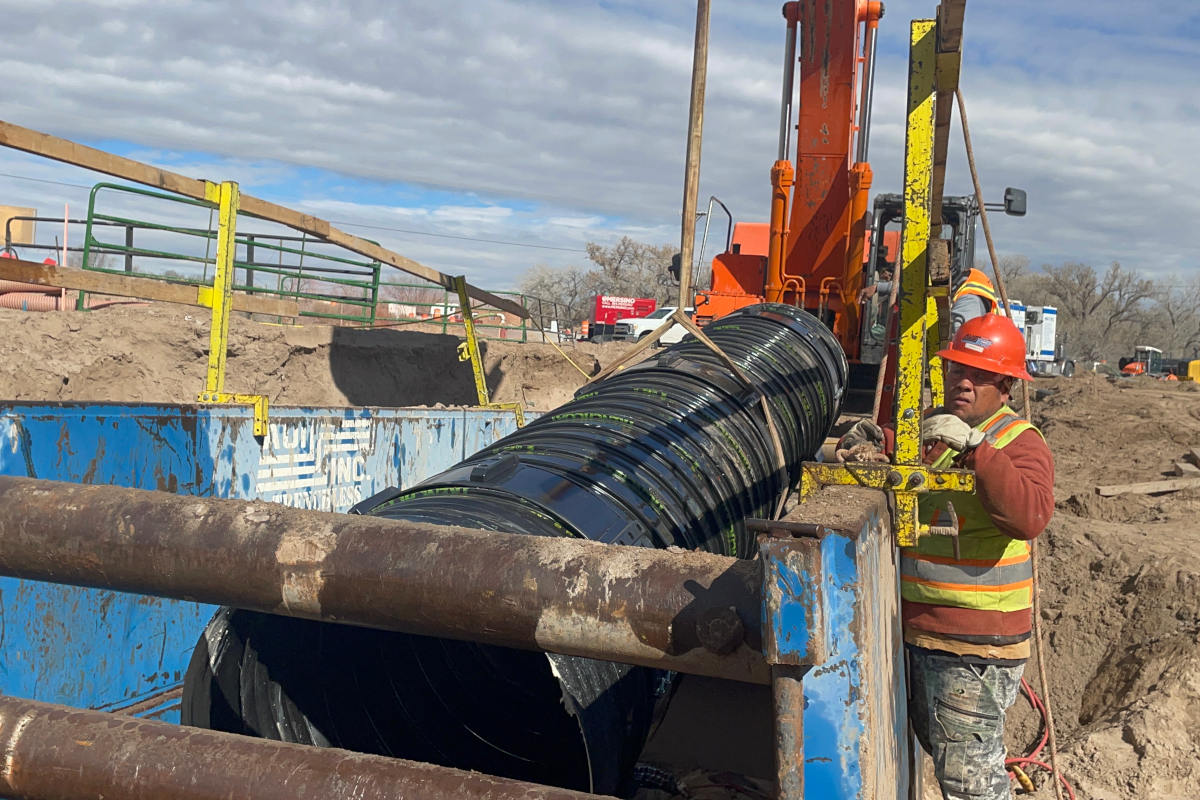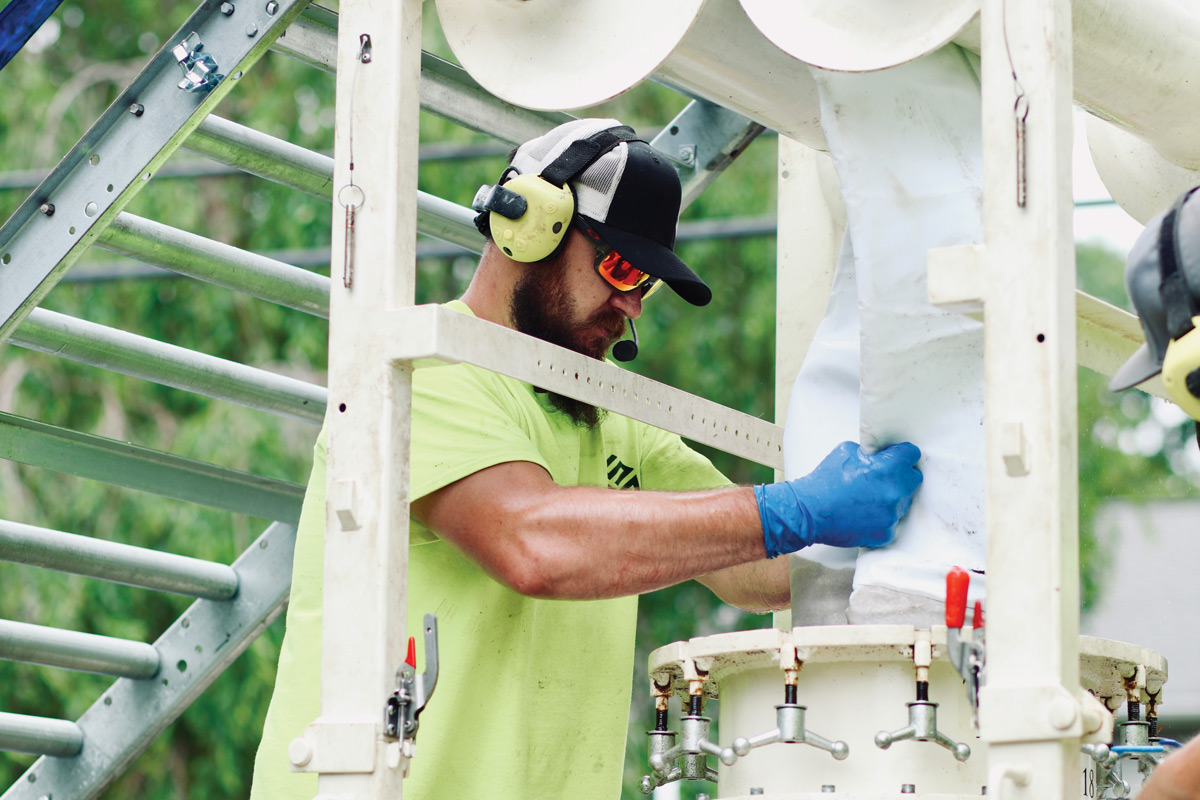
Culvert Rehab in Indiana
Precision Pipe and Products’ InfraSteel culvert rehabilitation system, was chosen by the Indiana Department of Transportation (INDOT) to slipline a deteriorating corrugated metal pipe (CMP) culvert that conveys the Little Calumet River under I-65, just north of the I-80/I-94 interchange, in Lake County, Indiana.
In 2008, engineers conducted an initial underwater inspection to determine the condition of the culvert structure. Installed in 1965, the structure measured 357-ft long with a 14-ft diameter, and was part of the initial interstate construction. The findings were presented to INDOT noting surface corrosion, steel delamination and pitting, and voids in the culvert structure. Additionally, severe corrosion around the voids allowed back-fill material to migrate under the pipe.
Following the initial report, a 2010 interchange reconstruction effort raised the I-65 profile grade approximately 5 ft over the culvert. However, no work was performed on the culvert during the interchange reconstruction. In 2012, a team comprised of INDOT and Parsons Engineering staff, conducted a field inspection noting the deficiencies in the structure. The sight survey included 10 interior measurements taken within the pipe, and the data verified the pipe had settled toward the mid-section, where the weight of the embankment was most severe. Furthermore, the pipe cross section had suffered deformation over the length of the culvert, presenting additional concern of the structural integrity of the pipe.
INDOT considered replacement of the culvert, sliplining with smooth wall carbon steel pipe, HDPE and CMP, and a variety of spray on products to repair the existing structure. INDOT also considered sliplining the existing structure and jacking and boring an adjacent culvert, creating a twin pipe structure. After analysis of the viable options, INDOT determined InfraSteel’s smooth wall carbon steel liner was the best product for the job. InfraSteel is manufactured for each specific project site in order to maximize hydraulic capacity and to meet load bearing requirements. Also, InfraSteel liners have a copper component for corrosion resistance, and they are designed in thicknesses up to 2 in., with a calculated design life.
RELATED: Sliplining Gives Failing Culvert a Second Life

Existing culvert condition prior to rehabilitation.
In 2019, INDOT released the project for bid specifying a 12-ft diameter InfraSteel liner. Midwest Mole, headquartered in Greenfield, Indiana, submitted the low bid. Midwest Mole was then awarded INDOT Project R-40386 with the goal to complete in summer 2020.
The culvert averaged flows of approximately 19,000 gpm. Therefore, the first step in the rehabilitation process required the installation of a bypass pumping system in order to de-water the site. It was decided that a 24-in. steel casing bored under the interstate, via the guided auger boring method, was required to assist with the discharge. However, slag was discovered under the interstate during the initial boring attempt, which required an up sizing of the steel casing pipe from 24 to 42 in. This was done in part to allow for human access inside the casing.

Sheet piling and dam construction prior to slipline rehabilitation.
The bypass system was designed to displace 35,000 gpm in order to minimize any possible flooding caused by heavy rain events. Steel sheeting was also driven into the river on both ends of the structure, and three pumps were installed upstream to create river flow diversion through the steel casing.
RELATED: Culvert Rehab Passes Hurricane Matthew Test
Once all of the all silt and debris was removed from the structure, a survey was then conducted that revealed a 3-ft bulge in the bottom of the existing structure, located in the middle of the run. Because of the bulge, it was determined that a 12-ft (144-in.) diameter liner would not fit inside the damaged culvert. Consequently, Midwest Mole proposed to down-size the InfraSteel liner 6 in. to an 11.5-ft (138-in.) diameter and submitted the change for approval.

INDOT then requested an inlet improvement design to maximize the reduced sized liner’s hydraulic capacity. InfraSteel responded by proposing a 150-in. diameter beveled inlet to capture additional head water. After a hydraulic review, INDOT accepted this as the final design.

Reducing section, located on upstream end of culvert.
Midwest Mole used a boring machine to push the InfraSteel liner into place. In addition, wood blocking was secured to the top of the culvert to eliminate any flotation during the grouting phase.
Once the liner was in place, Midwest Mole used approximately 600 cubic yards of pressurized grout to fill the annular space between the InfraSteel liner and existing structure. After the completion of the grouting process, the cross bracing was removed from inside of the liner.
RELATED: Collapsed Culvert – INDOT I-465 InfraSteel Stormwater Culvert Repair

A welder works in the interior of the liner to join liner sections. The full penetration welds limit the possibility of joint failure.
At the project location, I-65 is classified as an urban freeway with an average of 37,150 vehicles per day, 10 percent of which is heavy tractor trailer traffic. By using InfraSteel’s trenchless, slipline, methodology, INDOT was able to rehabilitate the degraded culvert with no impact to the roadway, and the end result is a new structure that will continue to serve the state for another 75 to 100 years.
States and counties with active culvert inspection programs are less likely to experience a catastrophic failure or roadway collapse.

A parallel system of steel channel along the invert and wood forms along the top, kept the liner in place during the installation and grouting phases.
It is important for infrastructure professionals to be aware of signs of impending culvert failure where there are streams and creeks. Common signs are dips in the roadway, pavement cracking, and eroding embankments.
Eric Kennedy and Alex Sherrod are with with Precision Pipe & products Inc.





